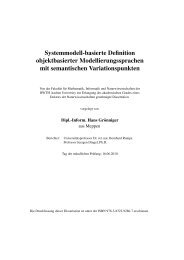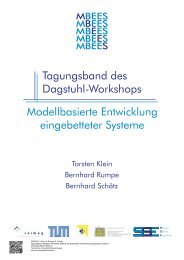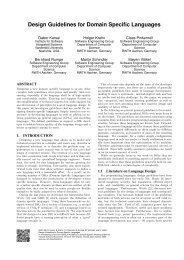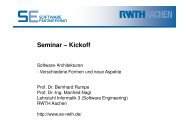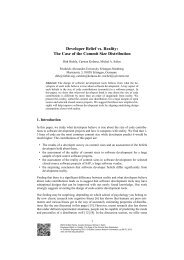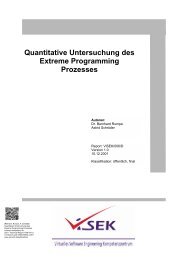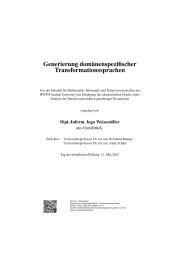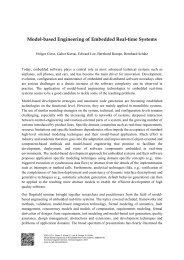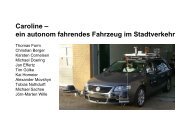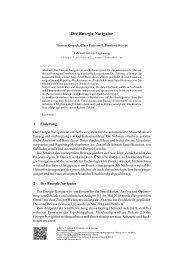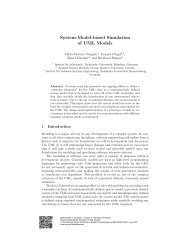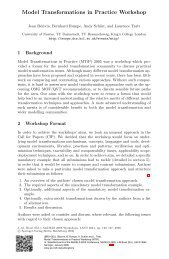Semantic Differencing for Activity Diagrams - Software Engineering
Semantic Differencing for Activity Diagrams - Software Engineering
Semantic Differencing for Activity Diagrams - Software Engineering
Create successful ePaper yourself
Turn your PDF publications into a flip-book with our unique Google optimized e-Paper software.
Finally, our current work supports a subset of the UML<br />
2 AD language. In particular, we do not yet support structured<br />
activity nodes, which allow hierarchical nesting of action<br />
nodes or reference from a node to another activity. Hierarchy<br />
is useful in medium and large scale designs, so supporting<br />
it is important. Moreover, a hierarchy induces an<br />
abstraction mechanism, which a semantic comparison may<br />
take advantage of. Additional language features may be<br />
added. We leave these <strong>for</strong> future work.<br />
6.2.2 Syntactic differencing and matching<br />
<strong>Semantic</strong> differencing in general, and addiff in particular,<br />
do not come to replace existing syntactic differencing approaches.<br />
Rather, they are aimed at augmenting and complementing<br />
existing approaches with capabilities that were<br />
not available be<strong>for</strong>e. Thus, combining addiff with existing<br />
approaches to matching and syntactic differencing (see,<br />
e.g., [14, 32]), is an important direction <strong>for</strong> future work. For<br />
example, we may extend the applicability of semantic differencing<br />
in comparing diagrams whose elements have been<br />
renamed or moved in the course of evolution, by applying<br />
a syntactic matching be<strong>for</strong>e running the semantic differencing.<br />
The result of such an integrated solution would be a<br />
mapping plus a set of diff traces. As another example, we<br />
may use in<strong>for</strong>mation extracted from syntactic differencing<br />
as a means to localize and improve the presentation and<br />
per<strong>for</strong>mance of the semantic differencing computation.<br />
7. RELATED WORK<br />
We discuss related work on AD <strong>for</strong>mal semantics and analyses,<br />
and on model and program comparisons.<br />
Eshuis [7] presents symbolic model checking of ADs. The<br />
work trans<strong>for</strong>ms ADs into SMV and uses the NuSMV model<br />
checker to verify LTL properties. The semantics given is<br />
partly inspired by the semantics of STATEMATE [9]. Our<br />
translation of ADs into SMV is somewhat similar to the two<br />
translations suggested in [7]. [7] does not handle data while<br />
our work does. The motivation of [7] is model checking while<br />
our motivation is model comparison. Störrle [31] defines a<br />
denotational semantics <strong>for</strong> UML 2 ADs as a mapping to<br />
procedural Petri nets. He also surveys and compares several<br />
previous studies that deal with a semantics <strong>for</strong> ADs, in terms<br />
of their semantic domain and expressiveness. Knieke and<br />
Goltz [12] present an executable semantics <strong>for</strong> UML 2 ADs<br />
with step semantics adapted from [9]. The works of [7, 12]<br />
support object nodes and several types of action nodes, while<br />
our current work supports only basic action nodes. Our work<br />
can be extended to support object nodes and other types<br />
of action nodes. Our focus is not on the different possible<br />
variants of ADs and their semantics but on the definition<br />
and the computation of the semantic diff operator we have<br />
presented, and on its use in evolution related tasks.<br />
Model and program differencing, in the context of software<br />
evolution, has attracted much research ef<strong>for</strong>ts in recent years<br />
(see [1, 6, 14, 21, 23, 32]). In contrast to our work, almost all<br />
studies in this area, however, present syntactic differencing,<br />
at either the concrete or the abstract syntax level.<br />
Alanen and Porres [1] describe the difference between two<br />
models as a sequence of elementary trans<strong>for</strong>mations, such<br />
as element creation and deletion and link insertion and removal;<br />
when applied to the first model, the sequence of<br />
trans<strong>for</strong>mations yields the second. Kuster et al. [14] investigate<br />
differencing and merging in the context of process<br />
models, focusing on identifying dependencies and conflicts<br />
between change operations. Engel et al. [6] present the use<br />
of a model merging language to reconcile model differences.<br />
Comparison is done by identifying new/old MOF IDs and<br />
checking related attributes and references recursively. Results<br />
include a set of additions and deletions, highlighted in<br />
a Diff/Merge browser. Mehra et al. [21] describe a visual differentiation<br />
tool where changes are presented using editing<br />
events such as add/remove shape/connector etc. Xing and<br />
Stroulia [32] present an algorithm <strong>for</strong> object-oriented design<br />
differencing whose output is a tree of structural changes,<br />
reporting differences in terms of additions, deletions, and<br />
moves of model elements, assisted by a set of similarity metrics.<br />
Ohst et al. [23] compare UML documents by traversing<br />
their abstract-syntax trees, detecting additions, deletions,<br />
and shifts of sub-trees.<br />
As the above shows, some works go beyond the concrete<br />
textual or visual representation and have defined the comparison<br />
at the abstract-syntax level, detecting additions, removals,<br />
and shifts operations on model elements. However,<br />
to the best of our knowledge, no previous work considers<br />
model comparisons at the level of the semantic domain, as<br />
is done in our work.<br />
Some works, e.g. [5, 32], use similarity-based matching be<strong>for</strong>e<br />
actual differencing. As our work focuses on semantics,<br />
it assumes a matching is given. Matching algorithms may<br />
be used to suggest a matching be<strong>for</strong>e the application of semantic<br />
differencing. The result of such an integration would<br />
be a mapping plus a set of differentiating traces.<br />
We are aware of only a few studies of semantic differencing<br />
between programs. Jackson and Ladd [11] summarise<br />
the semantic diff between two procedures in terms of observable<br />
input-output behaviors. Apiwattanapong et al. [2]<br />
present a behavioral diff <strong>for</strong> object-oriented programs based<br />
on an extended control-flow graph, and a tool that implements<br />
it in the context of Java. Finally, Person et al. [25]<br />
suggest to compute a behavioral characterization of a program<br />
change using a technique called differential symbolic<br />
execution. We focus on model comparison and not on program<br />
comparison. Also, while our work is somewhat similar<br />
to these works in terms of motivation, it is very different in<br />
terms of technology.<br />
8. CONCLUSION<br />
We presented addiff , a semantic differencing operator <strong>for</strong><br />
activity diagrams. Unlike existing approaches to model comparison,<br />
addiff per<strong>for</strong>ms a semantic comparison and outputs<br />
a set of diff witnesses, each of which is an execution trace<br />
that is possible in the first AD and is not possible in the<br />
second. We have <strong>for</strong>mally defined addiff , described two algorithms<br />
to compute it, a concrete one and a more scalable<br />
symbolic one, and demonstrated its application in comparing<br />
ADs within the Eclipse IDE. addiff can help developers<br />
to understand and evaluate the differences between versions<br />
of ADs so that they can reason about the impact of changes.<br />
When applied to the version history of a given AD, addiff<br />
provides a semantic insight into its evolution, which is not<br />
available in existing syntactic approaches.<br />
We suggested a number of future work directions in Sect. 6,<br />
among them, the development of more succinct, symbolic,<br />
or task-oriented representation of diff traces, the integration<br />
of addiff with existing approaches to matching and syntactic<br />
differencing, and the extension of addiff to cover a larger



